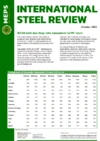EU & US cut a narrow path through Trump's trade wall
Authorities in the United States and the European Union recently pledged to end their long-running trade dispute over steel and aluminium.
Under the terms of the new agreement, a tariff-rate quota system will be implemented. This will be based on average import volumes in the three-year period prior to the introduction of Section 232 measures in 2018. In response, the EU has agreed to remove duties on a range of US products.
Between 2015 and 2017, the US imported an average of 4.3 million tonnes of steel per annum from the EU. Annualised figures for 2021 indicate that the inflow, in the current twelve-month period, will be approximately 2.5 million tonnes.
Steelmakers in the United States are forecast to produce 87 million tonnes, in 2021. A potential increase in EU-origin imports of 1.8 million tonnes equates to just over 2 percent of the total US output.
Consequently, the policy change will make a relatively minor difference to steel supply in the country. However, other major exporting nations, such as Japan, are expected to negotiate with US authorities, in an attempt to obtain a similar deal to that secured by the European Union.
US steel buyers will undoubtedly welcome the opportunity to purchase more material from outside the country. Most have been frustrated by their lack of supply options, in recent times.
Nevertheless, many market participants are uncertain how any future agreement will be enforced, and how volumes will be designated. A “first-come, first-served” scenario may lead to duties being paid on any volumes that exceed the quotas.
With the new arrangement coming into effect on January 1, European steel suppliers may be unable to take full advantage until mid-2022, at the earliest. Difficulties in shipping material to the US Midwest, during the winter period, are evident.
Furthermore, expensive freight costs and a shortage of available vessels are compounding transport problems worldwide. These supply bottlenecks are unlikely to be alleviated in the short term.
Nonetheless, EU steelmakers are attempting to capitalise on the new trade agreement, immediately. Mills are proposing price rises for local customers, anticipating that supply will tighten, amid increased export opportunities.
At this stage, however, the direct impact of the new US-EU trade agreement is expected to be limited, on both sides of the Atlantic.

Source:
International Steel Review
The MEPS International Steel Review is an essential monthly publication, offering professional analysis and insight into carbon steel prices around the world.
Go to productRequest a free publication





